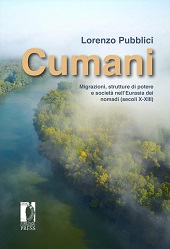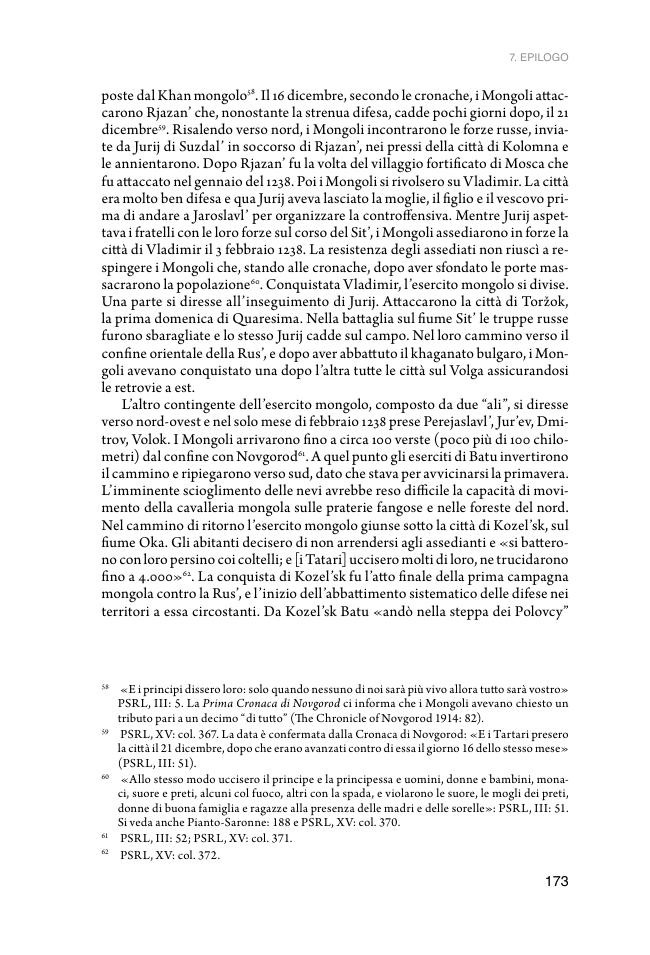Cumani : migrazioni, strutture di potere e società nell'Eurasia dei nomadi (secoli X-XIII)
343 p.
Includes bibliographical references (p. 281-324) and indexes.
Questo libro si propone come una sintesi sulle grandi migrazioni dei secoli VI-XIII, concentrandosi sullo spazio mediano fra i due grandi settori del continente eurasiatico: l'Europa Occidentale e l'Asia Orientale, rivalutando alla luce delle fonti la complessità delle relazioni fra i nomadi delle steppe e le società sedentarizzate che con essi entrarono in contatto. La scelta di concentrarsi sui Qïpčaq-Cumani è dovuta alla loro storia, unica perché non costituirono mai un centro di potere collettivo organizzato e centralizzato (stateless nomads); e paradigmatica, poiché racchiude tutti gli elementi costitutivi del nomadismo delle steppe: eterogeneità sociale, mobilità, preparazione militare, attrazione per il commercio e disponibilità alla trattativa.
Le migrazioni dei nomadi delle steppe e il loro arrivo a ridosso delle grandi comunità organizzate del mondo islamico e cristiano, dall'Asia all'Europa, hanno contribuito a innescare un processo di integrazione fra l'Asia e il bacino del Mediterraneo, un processo che l'invasione e la conquista mongole completarono dando vita a un nuovo spazio globale condiviso. Lorenzo Pubblici è Full Professor of History and Anthropology e Chair del Dipartimento di Humanities and Liberal Arts (DHLA) della Santa Reparata International School of Arts (SRISA) di Firenze. È, insieme a Marcello Garzaniti, direttore scientifico di CeSecom (Centro Studi sull'Europa Centro-Orientale del Medioevo) e direttore della collana Europe in Between. Autore di monografie, articoli e recensioni pubblicate sulle principali riviste scientifiche italiane e internazionali. Per FUP ha pubblicato Dal Caucaso al Mar d'Azov. Origine e conseguenze dell'invasione mongola in Caucasia fra nomadismo e società sedentaria (2018). [Testo dell'editore]
This book is a synthesis of the great migrations of the 6th-13th centuries, focused on the median space between the two extremes of the Eurasian continent: Western Europe and Eastern Asia. In the light of the sources, it aims to reassess the complexity of the relationships between the nomads of the steppes and the sedentarized societies that came into contact with them. The choice to focus on the Qïpčaq-Cumans is due to their history, unique because they never constituted an organized and centralized center of collective power (stateless nomads); and paradigmatic, because it encompasses all the constitutive elements of steppe nomadism: social heterogeneity, mobility, military preparation, attraction for trade and willingness to negotiate.
The migrations of the nomads of the steppes and their arrival close to the great organized communities of the Islamic and Christian world, from Asia to Europe, contributed to triggering a process of integration between Asia and the Mediterranean basin, a process that the Mongol invasion and conquest completed, giving birth to a new shared global space. Lorenzo Pubblici is Full Professor of History and Anthropology and Chair of the Department of Humanities and Liberal Arts (DHLA) of the Santa Reparata International School of Arts (SRISA) in Florence. Pubblici is, with Marcello Garzaniti, scientific director of CeSecom (Center of Studies on Central and Eastern Europe in the Middle Ages) and Editor in Chief of the book series Europe in between. He is the author of monographs, articles and reviews both in Italian and English. With FUP he published Caucasus to the Azov Sea. The Impact of the Mongol invasion in Cacuasia between nomadism and sedentary societies (1204-1295) 2018 (in Italian). [Publisher's text]
Online only available
-
Información



